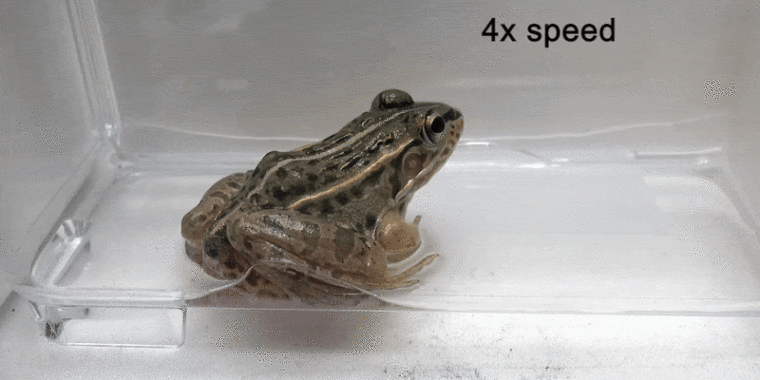Ursula Vernon, aka T. Kingfisher, won the 2023 Hugo for best novel and found inspiration for her acceptance speech in a 2020 study about a species of water beetle that survives being swallowed alive by a frog by escaping through the frog’s butt. Credit: Shinji Sugiura, 2020.
Inspiration can come from the most unlikely places, as fantasy author Ursula Vernon, aka T. Kingfisher, clearly knows. Vernon won the 2023 Hugo Award for Best Novel this past weekend for her dark fairy tale, Nettle and Bone, and while she was unable to travel to Chengdu Worldcon in China for the event, she posted the text of her acceptance speech (read at the ceremony by a friend) on her Patreon. After the usual preliminary remarks and thanks, Vernon opted to forego “serious and heavy” commentary for the following revelation:
There is a species of water beetle that regularly gets swallowed whole by frogs. And while there’s a lot of things you can do to keep from being eaten, once you’re inside a frog, your options are severely limited. Generally you get digested. But this particular species of beetle said “You know, I bet there’s another way.” And it started walking. In fact, it walked through the frog’s digestive tract and out the back end.
This is 100 percent true, you can look it up.
Naturally, we did look it up and honestly can’t believe we missed covering this fascinating study in 2020. (At least we didn’t miss the 2022 study on how certain species of beetle have evolved unusual “back pockets” to safely house symbiotic bacteria during metamorphosis, shuffling the populations out of those pockets via friction to the genital area as they emerge from their pupae.)
Shinji Sugiura of Kobe University in Japan discovered the unusual survival strategy of the aquatic beetle Regimbartia attenuata while looking into how predation pressures can lead to the evolution of innovative escape behavior in prey animals. He fed a bunch of the beetles to a pond frog (Pelophylax nigromaculatus) under laboratory conditions, expecting the frog to spit the beetle out. That’s what happened with Sugiura’s prior experiments on bombardier beetles (Pheropsophus jessoensis), which spray toxic chemicals (described as an audible “chemical explosion”) when they find themselves inside a toad’s gut, inducing the toad to invert its own stomach and vomit them back out.








